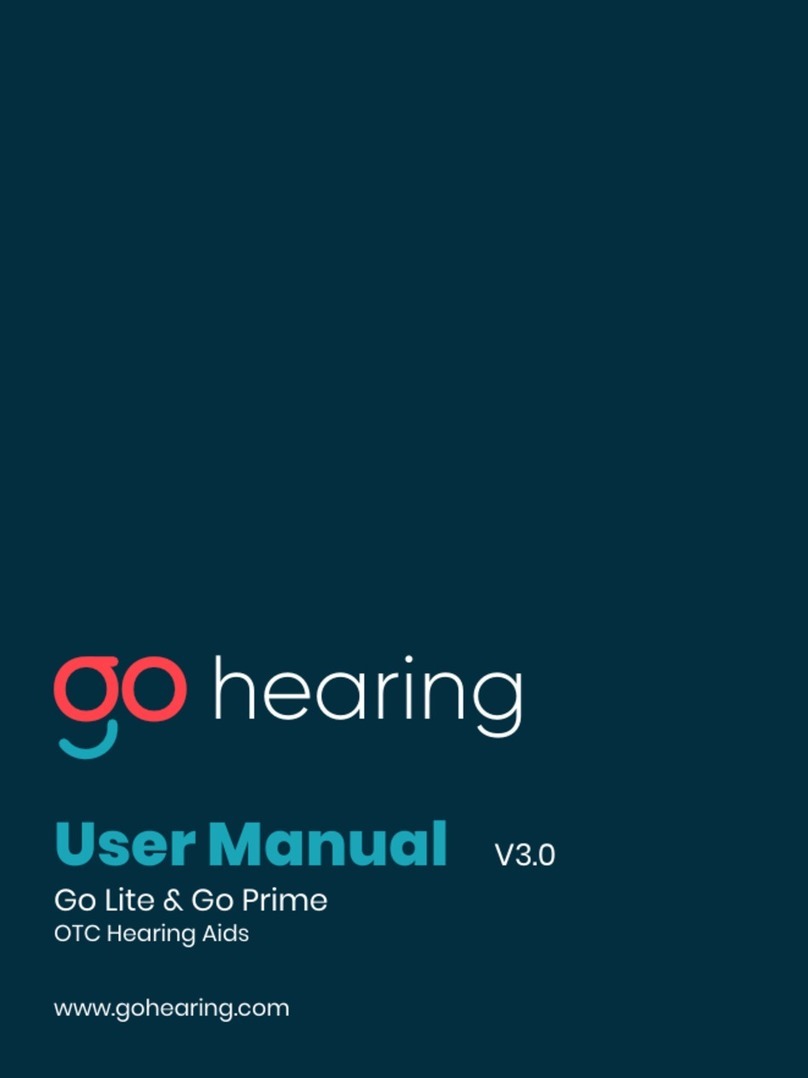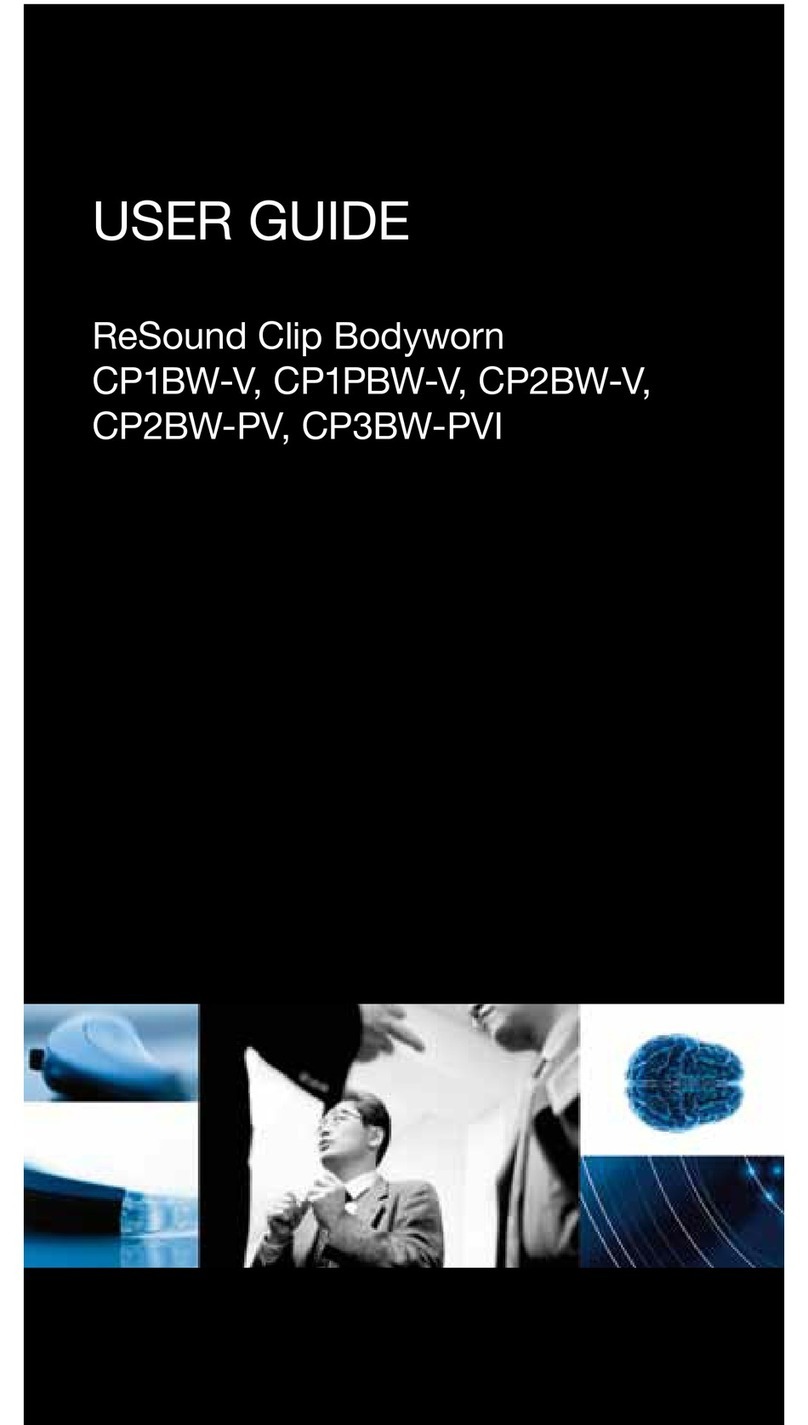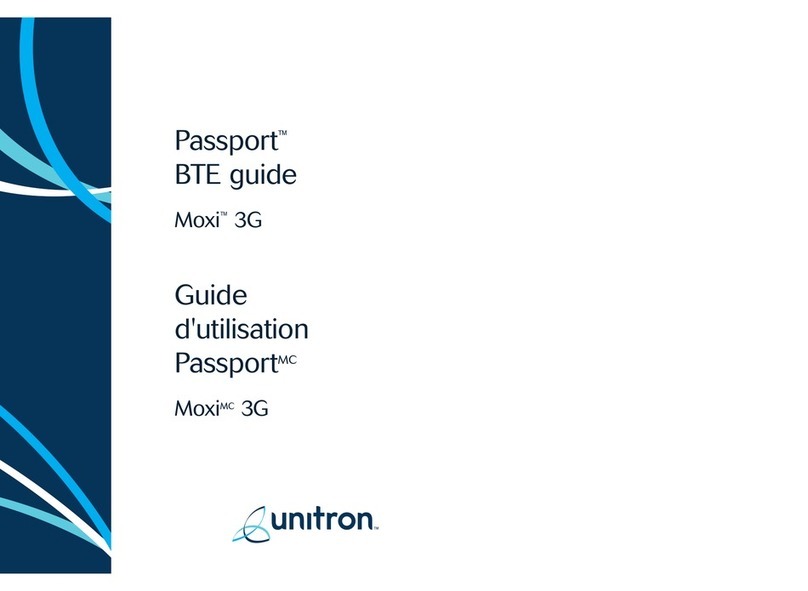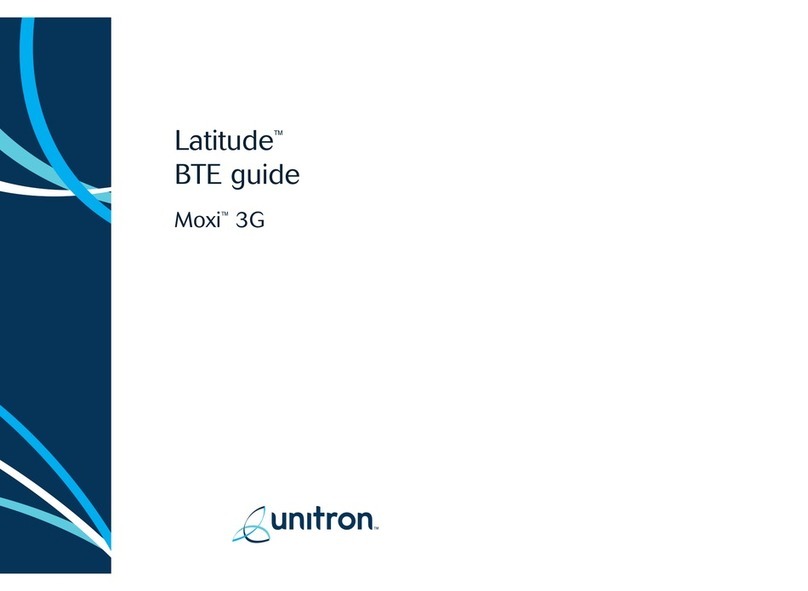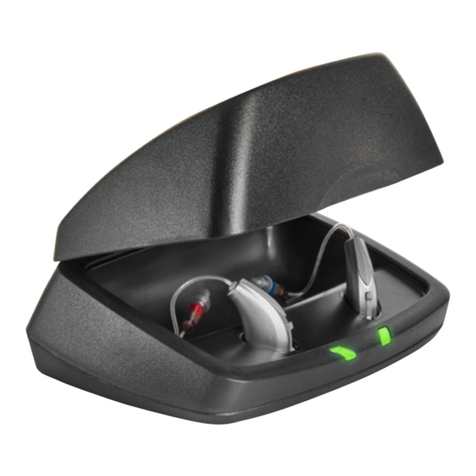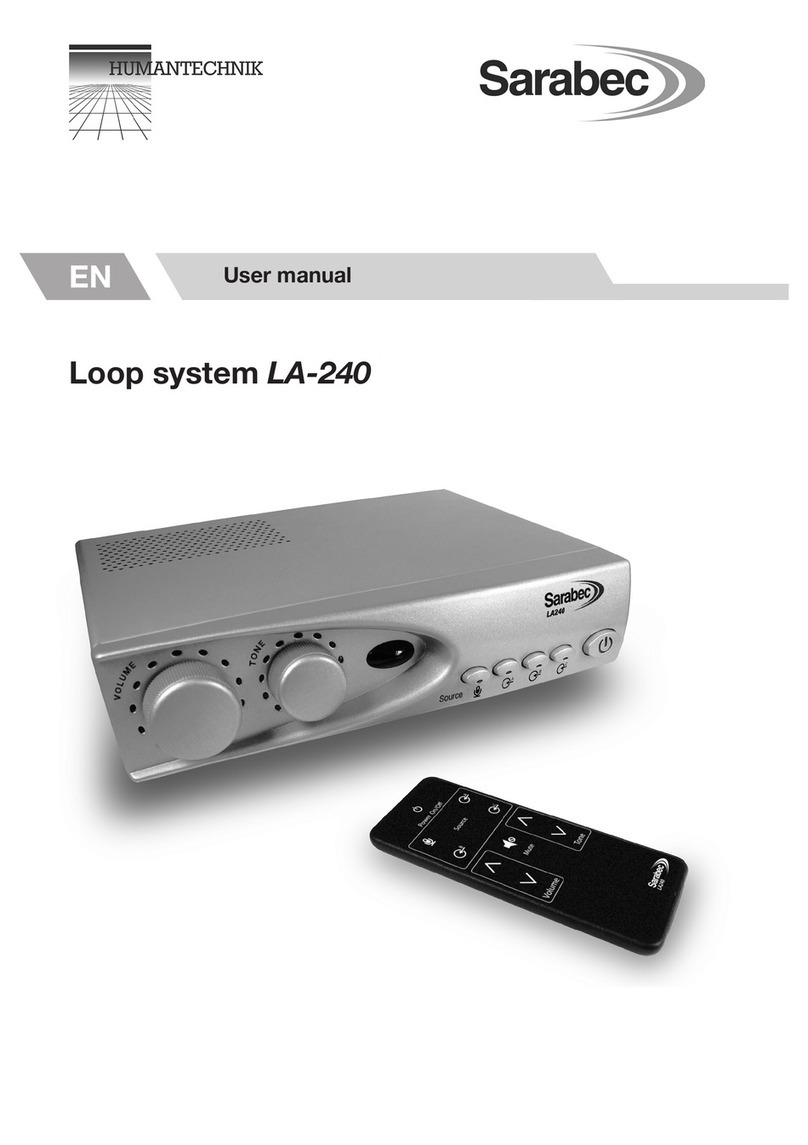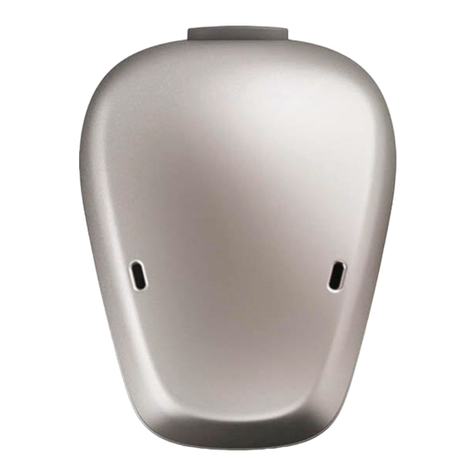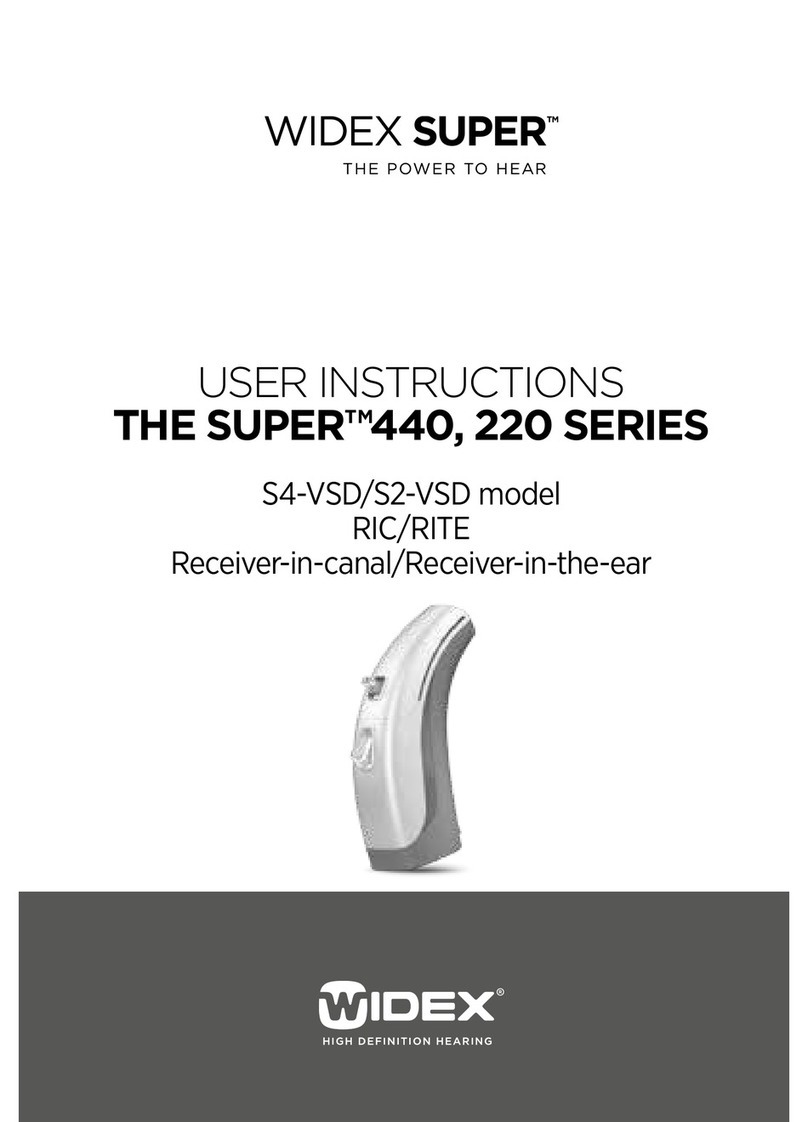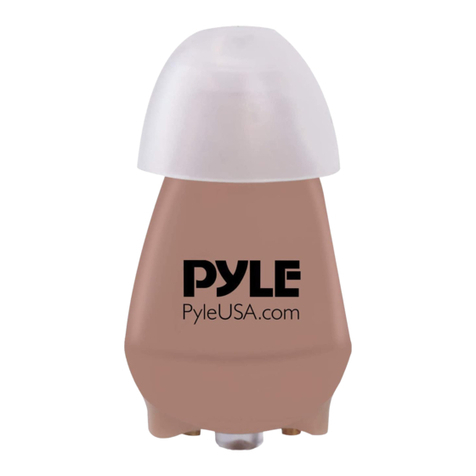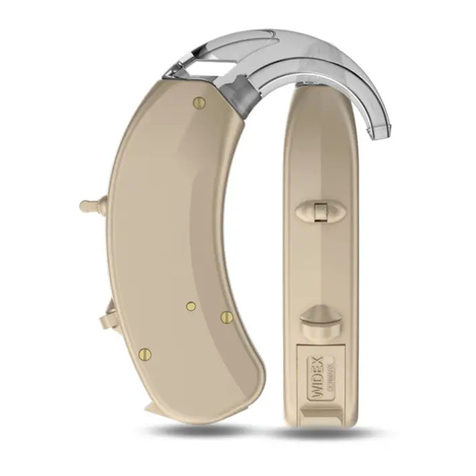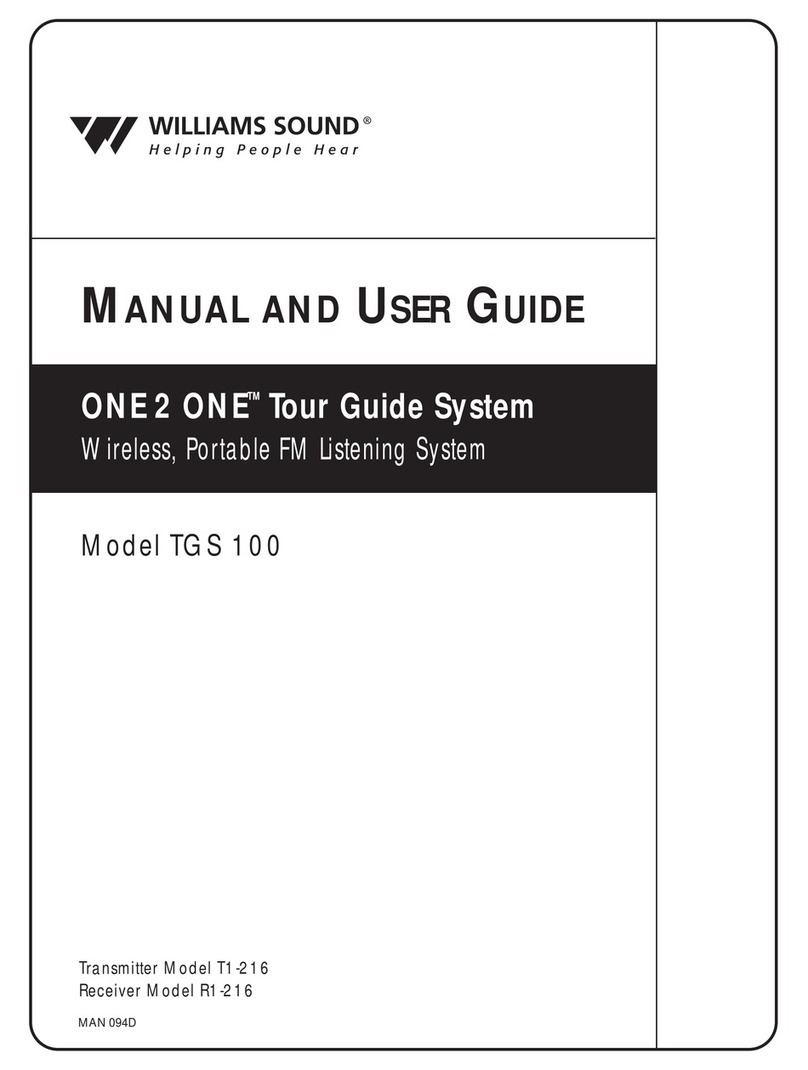go hearing Go Ultra User manual

User Manual V1.0
Go Ultra
OTC Hearing Aids
www.gohearing.com
hearing


Precautions and Warnings
WARNING: If you are younger than 18, do not use this. You should go to
a doctor, preferably an ear-nose-throat doctor (an ENT), because your
condition needs specialized care. Over-the-counter hearing aids are only for
users who are age 18 and older.
WARNING: When to See a Doctor
If you have any of the problems listed below, please see a doctor, preferably an
ear-nose-throat doctor (an ENT).
• Your ear has a birth defect or an unusual shape. Your ear was injured or
deformed in an accident.
• You saw blood, pus, or uid coming out of your ear in the past 6 months.
• Your ear feels painful or uncomfortable.
• You have a lot of ear wax, or you think something could be in your ear.
• You get really dizzy or have a feeling of spinning or swaying (called vertigo).
• Your hearing changed suddenly in the past 6 months.
• Your hearing changes: it gets worse then gets better again.
• You have worse hearing in one ear.
• You hear ringing or buzzing in only one ear.
This OTC hearing aid is for users who are 18 and older. People who are younger than
18 with hearing loss should see a doctor, preferably an ENT, because they may need
medical testing and management. Hearing loss can affect speech and learning, so
professional tting and continuing care are also important.

WARNING: This hearing aid should not cause pain when inserting it. Remove this
device from your ear if it causes pain or discomfort when you insert or place it.
To try again, make sure to follow the instructions. If you feel pain or discomfort
again, contact the manufacturer. If your pain or discomfort doesn’t go away,
contact your hearing healthcare professional. You can also report this to FDA as
an adverse event according to the instructions that appear later.
These PRECAUTIONS point out situations which could cause minor or moderate
injuries to the user or to the hearing aid.
• You should familiarize yourself fully with the entire contents of this user manual
before using the Go hearing aid to ensure personal safety and correct use.
Contact the Go contact center for support if you experience unexpected
operations or performance.
• Do not attempt to modify the shape of the hearing aids yourself.
• For best results, use hearing aid accessories provided by Go Hearing.
• Never leave your hearing aids where small children and pets can reach them.
These WARNINGS point out situations which could cause serious injuries to the
user or to the hearing aid.
• In some acoustic environments, over amplication can cause discomfort and
damage to the patient’s hearing.
• Do not use your hearing aids in explosive or oxygen-enriched areas.
• Allergic reactions to hearing aids are unlikely. However, if you experience
itching, redness, soreness, inammation, or a burning sensation in or around
your ears, inform a hearing healthcare provider and contact your physician.

• You may notice accelerated accumulation of earwax when using your
hearing aid. This is normal, but see your hearing healthcare provider if you
continue to have difculty.
• In the unlikely case that any parts remain in the ear canal after the removal
of the hearing aid, contact a physician immediately. Report the event to your
hearing healthcare provider as soon as possible.
• Remove your hearing aids for CT and MRI scans or for other electromagnetic
procedures.
• Never leave your hearing aids and/or charging case where small children and
pets can reach them.
• If you feel pain in or behind your ear, if it is inamed, if skin irritation or
accumulations of ear wax occur, please check with a hearing healthcare
provider, preferably an ear-nose-throat doctor (ENT).
• If you have active implantable devices, please keep magnets (ie. the charging
case) at least 6 inches away from the active implant.
• Do not cover the whole charging case while charging with the charging cable,
e.g. with a cloth etc.
• Please do not share your hearing aids with other people.
• Sleeping with your hearing aids in your ears is not recommended. Risks
vary from damaging your hearing aids to experiencing discomfort and/or
feedback. You will nd, however, that there are many assistive devices
available to you, such as wake-up alarms that can be placed under your
pillow or wristbands that vibrate when you have a phone call.
• Contact +1 302 754 3190 for support if you experience unexpected operations
or performance.

Caution: The sound output should not be uncomfortable or painful. The
sound output should not be uncomfortable or painful. You should turn down
the volume or remove the device if the sound output is uncomfortably loud
or painful. If you consistently need to turn the volume down, you may need to
further adjust your device.
Caution: You might need medical help if a piece gets stuck in your ear. If
any part of your hearing aid, like the eartip, gets stuck in your ear, and you
can’t easily remove it with your ngers, get medical help as soon as you can.
You should not try to use tweezers or cotton swabs because they can push
the part farther into your ear, injuring your eardrum or ear canal, possibly
seriously.
Note: If you remain concerned, consult with a professional. If you try this
device and continue to struggle with or remain concerned about your
hearing, you should consult with a hearing healthcare professional.
Caution and notices for users
Caution: This is not hearing protection. You should remove this device if you
experience overly loud sounds, whether short or long-lasting. If you’re in a
loud place, you should use the right kind of hearing protection instead of
wearing this device. In general, if you would use ear plugs in a loud place, you
should remove this device and use ear plugs.

Note: Tell FDA about injuries, malfunctions, or other adverse events. To
report a problem involving your hearing aid, you should submit information
to FDA as soon as possible after the problem. FDA calls them “adverse
events,” and they might include: skin irritation in your ear, injury from the
device (like cuts or scratches, or burns from an overheated battery), pieces
of the device getting stuck in your ear, suddenly worsening hearing loss from
using the device, etc.
Instructions for reporting are available at https://www.fda.gov/Safety/
MedWatch, or call 1-800-FDA-1088. You can also download a form to mail
to FDA.
Note: What you might expect when you start using a hearing aid. A hearing
aid can benet many people with hearing loss. However, you should know
it will not restore normal hearing, and you may still have some difculty
hearing over noise. Further, a hearing aid will not prevent or improve a
medical condition that causes hearing loss. People who start using hearing
aids sometimes need a few weeks to get used to them. Similarly, many
people nd that training or counseling can help them get more out of their
devices. If you have hearing loss in both ears, you might get more out of
using hearing aids in both, especially in situations that make you tired from
listening-for example, noisy environments.

Welcome to your Go Ultra OTC
Hearing Aids.
This manual will provide you with all the information you need
to use and maintain your new OTC hearing aids.
For additional information on the use of these hearing aids visit
www.gohearing.com.

What’s inside the box
Get to know your hearing aids
Hearing aid overview
Setting up and use
Using your hearing aids
Charging the hearing aids
Cleaning, maintenance and care
Consumables
Troubleshooting
Warranty
Contact us
Information and description of symbols
2
3
5
7
17
25
30
35
36
44
44
48
Table of Contents
11

2What’s inside the box?
1 x pair of Go Ultra OTC hearing aids
6 x Open domes
(Small, medium and large sizes)
6 x Closed domes
(Small, medium and large sizes)
1 x Charging case
6x Slim tubes
(2x size 1, 2x size 2, 2x size 3)
Power
adaptor
1 x Charging cable for
the charging case
1 x Cleaning brush
2 x Cleaning wires
1 x Ear measuring tool

Intended use
The Go Ultra hearing aids are a pair of wireless air conduction
OTC hearing aids intended for use by individuals 18 years and
older with perceived mild to moderate hearing loss
Indication of use
The Go Ultra hearing aids are intended to amplify sound for
individuals 18 years of age or older with perceived mild to
moderate hearing loss. No preprogramming or hearing test
is necessary. They are adjusted by the user to meet the user’s
hearing needs. Although wearing one hearing aid is possible, it
is recommended that users wear two hearing aids. Wearing two
hearing aids instead of one has been proven to lead to better
outcomes. Users are urged to wear their hearing aids frequently
to obtain the full benet. The devices are intended for over-the-
counter sale and use without the assistance of a hearing care
professional.
This product may not be right for you if you:
• Consistently experience feedback (whistling) of the hearing
aid when you turn up the volume to a level that is comfortable
for you, even after you have followed the suggestions in this
User Manual to make sure your hearing aid ts properly.
Get to know your hearing aids 13

• Feel the hearing aid is not providing enough amplication
even at the highest volume level. A hearing healthcare
professional may be able to help you select a different
hearing aid solution to meet your needs.
4

Hearing aid overview 15
Microphone
Charging
contacts
Dome
Slim
tube
Retention
wire
Multi-function
Switch A
Multi-function
Switch B
Microphone - sound enters your hearing aids through the
microphone
Multi-function Switch A - volume increase and hearing aid ON/
OFF
Multi-function Switch B - volume decrease and hearing
programs change
Slim tube - connects the dome to the hearing aid
Retention wire - helps prevent the dome from moving out of
the ear canal
Dome - domes are soft silicon domes, and hold the hearing
aid comfortably and securely in the ear canal
Charging contacts - to charge the hearing aids
1.
2.
3.
4.
5.
6.
7.

6
Accessories Description
Multiple silicon domes
6 x Open domes
2x per size: Small, medium
and large
6 x Closed domes
2x per size: Small, medium
and large
Attaches to the tubing on the hearing aid and ts
inside your ear canal.
Multiple slim tubes
6 x slim tubes
2 per size: 1,2 & 3
A thin plastic tube that connects to the body of
the hearing aid. It connects to the dome that gets
inserted into the ear canal.
Charging case Use to charge your hearing aids when the battery
runs at.
Charging cable Use to charge the charging case.
Cleaning brush Use to softly brush and clean the hearing aid to
keep it free from particles and debris build up.
Cleaning wire A very thin wire that is used to clean the slim tubes.
Ear measuring tool Use to measure the size of your ear, to select the
correct size slim tube.

Setting up your Go Ultra hearing aids
Before you can begin using your Go Ultra hearing aids, you will
be required to select the correct slim tube length and dome size
for your specic ear. This is an important process that will allow
you to get comfortable with the t and feel of your hearing aid.
Selecting the correct slim tube
In order to select the correct slim tube length, it is important to
rst measure the size of your ear by using the ear measuring
tool provided. This measuring tool will allow you to determine
which slim tube would be the most comfortable t for your ear.
Slim tubes are available in three different lengths namely, size 1,
2 and 3, with size 1 being the shortest in length and size 3 being
the longest. The ear measuring tool will indicate which slim tube
length will be the best t for your ear. Follow the steps below in
order to complete this process:
Setting up and use 17
The ear measuring tool has two
colors, namely red and blue. Begin
by placing the measuring tool over
your ear as illustrated. The red side
must be showing when it is over your
right ear and the blue side must be
showing when it is over your left ear.
1.
Top of
ear canal

On your ear measuring tool, locate the closest number that is
most parallel to the top of the opening of your ear canal. This
number will be needed in order to select the correct slim tube
length.
At the bottom of each slim tube, you will nd a number in
either blue or red. Just as with the ear measuring tool, a slim
tube with a red number on it, will indicate that the slim tube is
intended for the right ear and a slim tube with a blue number
on it, will indicate that the slim tube is intended for the left ear.
Once you have determined the correct slim tube length for
your ear, nd the slim tube with the correct number and color
that is needed for your hearing aid.
Select the correct slim tube recommended by the ear
measuring tool. If you have two hearing aids, repeat this
process for your opposite ear.
Take a photo of your ear so that you can clearly see
the measuring tool on your ear. You may need to ask a
family member or friend to assist you with this step, if you
experience any difculties.
3.
4.
5.
6.
2.
8

Removing and attaching your slim tube to your
hearing aid
Each Go hearing aid comes with a standard size 2 slim tube
attached to it. Should you need to replace this slim tube, follow
the steps below.
1
9
Remove the slim tube by holding the wider/thicker part of
the hearing aid body with one hand. With the opposite hand,
rmly grip the base of the slim tube where it connects to the
hearing aid. Turn the slim tube 90 degrees anticlockwise and
pull the tube off the hearing aid.
Attach the new slimtube, by aligning the base of the slim tube
with the hearing aid and gently, but rmly push it onto the
hearing aid until it clicks into place. Once attached correctly,
the base of the slimtube should align with the body of the
hearing aid.
1.
2.

10
Note: Make sure to grip the base of the slim tube and not
the tube itself.
Note: Be careful not to bend the slim tube sideways. This
will cause a kink or narrowing of the tube resulting in the
obstruction of soundow through the tube.
Selecting the correct dome size
Each Go hearing aid comes with two different types of domes,
namely open and closed domes. The domes are made out
of medical-grade silicon and attach to the end of the slim
tube. The two dome types come in three different sizes: small,
medium and large respectively.
Try the different domes to nd the most comfortable t for your
ear canal. The dome should t snugly in the ear canal opening
so that the ear canal is properly sealed. In other words, the
dome shouldn’t feel like it is falling out of the ear or that it has to
be squeezed or forced into the ear.
If it feels like the dome is falling out of your ear, it means that
the dome is most likely too small for your ear. Try changing
your dome to one that is a size larger. If it feels like you have
to squeeze or force the dome into your ear, it means that the

111
dome is most likely too large for your ear. Try changing your
dome to one that is a size smaller. It is useful to know when to
use a closed or open dome.
Good fit Too small
Dome types
Within each dome size, there are two types of domes; open and
closed.
Open domes help your voice sound more natural. They have
openings around the center of the dome.
Closed domes provide more bass and allow you to comfortably
use a higher volume setting.

Removing and attaching your dome to the slim tube
Follow the steps below in order to remove and attach a dome
on your slim tube when necessary.
1 2 3
Hold onto the end of the slim tube that is closest to the dome.
Use your other hand to grasp the dome between your
forenger and your thumb and carefully pull off the dome
from the end of the slim tube.
1.
2.
12 Try another dome type
During the rst-time setup, use the default open domes and
focus on nding the correct size for each ear. After using
the hearing aids for some time, if you feel you need more
amplication or hear whistling at higher volume settings,
consider trying closed domes.
Other go hearing Hearing Aid manuals
